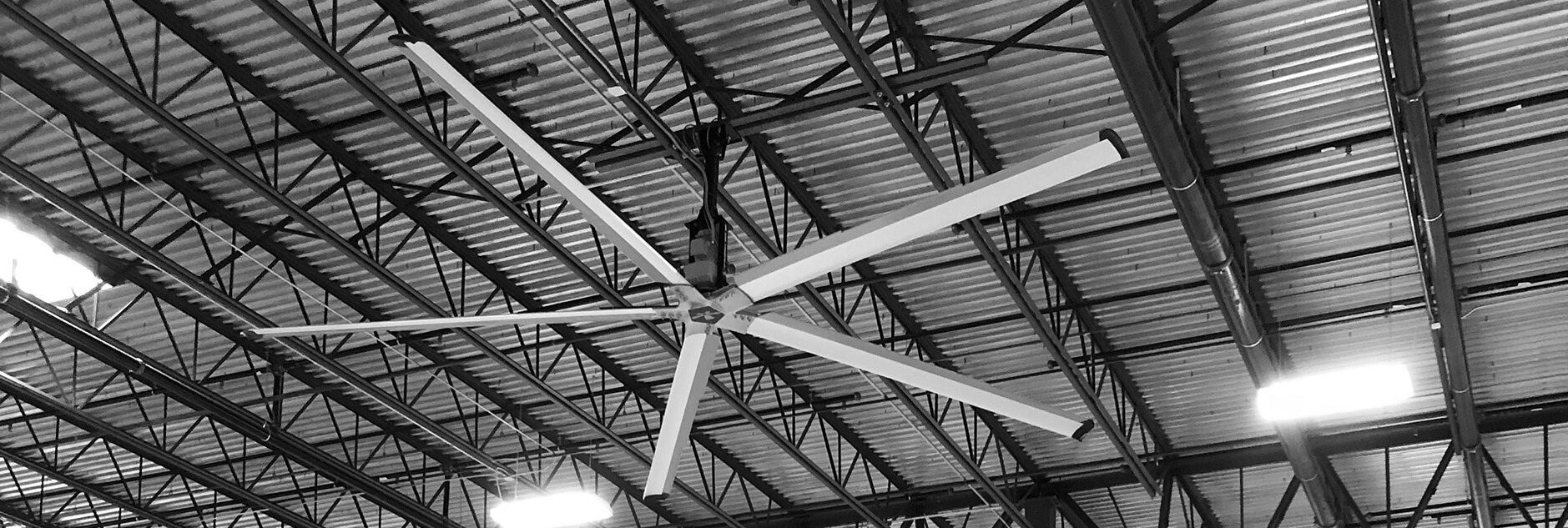HVLS Fan Terminology Guide


When it comes to air science, we can kick around a lot of terminology. HVLS, CFM, dead zones… what does it all mean? Our air scientists are here to help. This guide provides an explanation of key terms as well as why they are important factors to consider when purchasing a fan.
HVLS Fans
HVLS stands for high volume, low speed. Engineered for energy efficiency, these fans are designed to move substantial volumes of air while rotating at slower speeds. They work by generating a steady column of slow-moving air that circulates evenly throughout a space, providing consistent and gentle airflow. HVLS fans excel in demanding environments like industrial and commercial facilities where a standard fan would fall short or an HVAC system would be costly to run.
CFM
Cubic feet per minute (CFM) is a unit of measurement that quantifies the rate air is circulated through a space – in this case, your facility – in 60 seconds. For example, a 20,000³ room would need a fan with at least 20,000 CFM to replace all the air each minute. To maintain a safe and comfortable working environment, it’s important for the air inside your facility to be regularly turned over. Z-Tech blades generate an industry leading cubic feet per minute of air circulation.
RPM
RPM stands for rotations per minute. It stands for the number of times a fan’s blades complete a full rotation in one minute. A higher RPM means faster and more powerful air movement, while a lower RPM means slower and gentle air movement. HVLS fans are engineered using the science of fluid dynamics to provide expansive air circulation without having to function at high speeds, reducing energy costs while keeping your facility cool. Our fans don’t have to run at warp speed to be effective.
IAQ
Indoor Air Quality (IAQ) refers to the air quality within and around buildings and structures, especially as it relates to the health and comfort of building occupants. There’s not one measurement that can determine if a building’s indoor air quality is good or bad, rather, IAQ is defined by a combination of different factors. HVLS fans have been proven to improve air quality by controlling temperatures and managing humidity.
Destratification
Destratification is the process of moving warm air stuck at the ceiling back down to the floor where it’s needed. As air descends, it spreads horizontally just above the ground before eventually ascending back to the ceiling, only to be cycled down again. This continuous movement of air provided by HVLS fans results in even temperatures throughout your facility, keeping employees comfortable and productive.
Blade Pitch
Pitch measures the angle of the blades compared to the ground. Fan blades are slightly angled in order to push air around efficiently. If all blades were parallel to the floor, there wouldn’t be much airflow. Our Z-Tech fan has a 20 degree+ pitch and generates 30% more coverage than other HVLS fans in its class.
Dead Zones
Dead zones are pockets of stagnant air directly beneath a fan’s central hub. Air flows out from fans in a spiral or cylindrical pattern, cooling away from the fan but not immediately underneath. Bigger fans usually have a bigger dead zone – except for VividAir. Our unique pitched hub technology eliminates dead zones and cools your entire facility, even directly beneath the fan. Your workers will always feel the effects of our fans no matter where they’re standing.
True Reversibility
True reversibility speaks to VividAir’s technology that allows blades to spin clockwise and counterclockwise. This customizes airflow according to the season. Counterclockwise blades create a downdraft to push air down in the summer, keeping facilities cool. Clockwise blades pull air upwards in the winter, recycling heated air. Our patented pitched hub allows our fans to function at the exact same effectiveness in both directions, year-round.
With a better understanding of key HVLS fan terminology, you can know you’re making the right choice for your facility when choosing a fan. Our air scientists are available as a resource to explain our technology and help you navigate your needs. Ready to learn more? Contact us below.
